Street photography is a captivating genre of photography that captures the raw, unscripted moments of everyday life in public spaces. It is an art form that preserves fleeting instances of human interaction, emotion, and culture within the urban landscape. From candid portraits to unexpected juxtapositions, street photography reveals the beauty, humor, and complexity of the world around us.
In this article, we will explore the history, techniques, and ethics of street photography, as well as the work of some influential practitioners.
A Brief History of Street Photography
Street photography’s roots can be traced back to the early days of photography in the mid-19th century when pioneers like Charles Nègre and Henri Cartier-Bresson began documenting the streets of Paris with their cameras. As photographic technology improved and became more accessible, street photography flourished, with photographers around the world capturing the essence of their cities and societies.
The 20th century saw the rise of iconic street photographers like Robert Frank, Garry Winogrand, and Diane Arbus, who pushed the boundaries of the genre and inspired generations of photographers. Today, street photography remains a popular and ever-evolving art form, with contemporary photographers utilizing digital technology and social media to share their work with a global audience.

Techniques and Tips for Street Photography
- Be Observant: Successful street photography relies on the photographer’s ability to observe and anticipate moments. Keep your eyes open and be aware of your surroundings, looking for interesting scenes, gestures, or expressions.
Move Unobtrusively: To capture candid moments, it’s essential to blend into the environment and avoid drawing attention to yourself. This may involve using a smaller camera, avoiding eye contact, or even pretending to photograph something else.
Master Your Camera: Knowing your camera’s settings and capabilities is crucial in street photography, as situations can change rapidly. Familiarize yourself with your gear and be prepared to adjust settings quickly to adapt to different lighting conditions and circumstances.
Experiment with Composition: Street photography offers endless opportunities to play with composition. Look for leading lines, patterns, or contrasts to create visually striking images. Experiment with different angles and perspectives to capture unique viewpoints.

- Embrace the Unexpected: One of the joys of street photography is its unpredictability. Embrace the unexpected and be open to capturing whatever unfolds before your lens, even if it wasn’t what you originally intended.
Ethics in Street Photography
Street photography often raises ethical questions, as it involves capturing images of people in public spaces without their explicit consent. While laws regarding photography in public places may vary by country, it’s essential to consider the potential impact of your images on the subjects.
Be respectful of people’s privacy and avoid taking photos that could cause distress or harm. If someone expresses discomfort or asks you not to photograph them, be respectful and comply with their wishes. Additionally, be conscious of cultural sensitivities and local customs when photographing in unfamiliar environments.
Influential Street Photographers
Throughout its history, street photography has seen numerous influential practitioners. Here are a few notable names:
Henri Cartier-Bresson: Often considered the father of modern photojournalism, Cartier-Bresson’s work defined the concept of “the decisive moment” in photography. His candid images captured the essence of life and human emotion.
Vivian Maier: A secretive nanny, Maier’s incredible street photography was only discovered after her death. Her extensive body of work offers a unique perspective on American life in the mid-20th century.
Robert Frank: With his groundbreaking book “The Americans,” Frank offered a raw and unflinching look at post-war American society, challenging traditional conventions of documentary photography.

Garry Winogrand: Known for his energetic and chaotic style, Winogrand captured the essence of American life in the 1960s and 1970s, exploring themes of social issues, alienation, and the human condition.
Alex Webb: Renowned for his use of vibrant color and complex compositions, Webb’s work often explores the cultural and political dynamics of various locations, from the streets of Istanbul to the US-Mexico border.
Street photography is a powerful and evocative art form that allows us to explore and connect with the world around us. By capturing the fleeting moments and emotions of everyday life, street photographers offer a unique perspective on humanity and the urban landscape. As you venture into the world of street photography, remember to be observant, respectful, and open to the unexpected – and most importantly, enjoy the journey.
